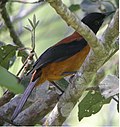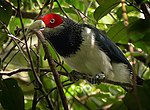A mixed-species feeding flock, also termed a mixed-species foraging flock, mixed hunting party or informally bird wave, is a flock of usually insectivorous...
25 KB (2,918 words) - 23:08, 13 November 2024
species than can be variable and widespread. Not to be confused with a mixed-species foraging flock, a behavior in which birds of different species feed...
42 KB (3,676 words) - 22:52, 3 November 2024
Flocking also offers foraging benefits and protection from predators, although flocking can have costs for individual members. Flocks are often defined as...
12 KB (1,458 words) - 09:46, 10 September 2024
suggested that pishing may be treated as an invitation to join a "mixed-species foraging flock" and birds do not themselves vocalize or show aggressive behaviour...
4 KB (549 words) - 21:57, 4 August 2024
Bar-winged flycatcher-shrike (category IUCN Red List least concern species)
is found hunting in the mid-canopy of forests, often joining mixed-species foraging flocks. They perch upright and have a distinctive pattern of black...
12 KB (1,276 words) - 18:18, 27 February 2024
Velvet-fronted nuthatch (category IUCN Red List least concern species)
with good tree cover and are often found along with other species in mixed-species foraging flocks. Adult males can be told apart by the black stripe that...
15 KB (1,787 words) - 16:16, 2 November 2024
Black-naped monarch (category IUCN Red List least concern species)
flycatcher, and in tropical forest habitats, pairs may join mixed-species foraging flocks. Populations differ slightly in plumage colour and sizes. The...
18 KB (1,939 words) - 13:22, 10 November 2024
Fish migration (redirect from Highly migratory species)
organism. List of diadromous orders and families, and the number of known species: Forage fish often make great migrations between their spawning, feeding and...
27 KB (2,821 words) - 04:47, 25 October 2024
Greater racket-tailed drongo (category IUCN Red List least concern species)
help in the formation of mixed-species foraging flocks, a feature seen in forest bird communities where many insect feeders forage together. These drongos...
22 KB (2,437 words) - 12:57, 24 September 2024
Hooded pitohui (category IUCN Red List least concern species)
frequently joins and even leads mixed-species foraging flocks. Its diet is made up of fruits, seeds and invertebrates. This species is apparently a cooperative...
30 KB (3,612 words) - 10:11, 24 September 2024
Grey-headed canary-flycatcher (category IUCN Red List least concern species)
habitats where they often join other birds in mixed-species foraging flocks. Pairs are often seen as they forage for insects by making flycatcher-like sallies...
12 KB (1,278 words) - 20:39, 24 June 2024
Scarlet minivet (category IUCN Red List least concern species)
habits of gleaning for insects and are often seen in mixed-species foraging flocks, usually foraging in small groups, high up in the forest canopy. The...
6 KB (632 words) - 09:53, 2 March 2024
Dark-fronted babbler (category IUCN Red List least concern species)
best indication that these birds are present. They often join mixed-species foraging flocks. The breeding season is May to July. This babbler builds its...
10 KB (1,042 words) - 22:30, 10 January 2024
Bronzed drongo (category IUCN Red List least concern species)
mixed-species foraging flocks. They are very good in mimicking calls of many other bird species which is a trait shared with many Drongo species. The breeding...
6 KB (621 words) - 06:03, 22 April 2024
Indian scimitar babbler (category IUCN Red List least concern species)
leaves or probe in leaf litter for prey. They may sometimes join mixed-species foraging flocks. They breed from December to May. The nest is a large and loose...
9 KB (957 words) - 17:21, 27 June 2024
Eurasian nuthatch (category IUCN Red List least concern species)
healthy wood like a woodpecker. A pair may temporarily join a mixed-species foraging flock as it passes near their territory. The Eurasian nuthatch readily...
41 KB (4,848 words) - 06:57, 2 November 2024
Red-faced malkoha (category IUCN Red List vulnerable species)
mixed-species foraging flocks in the Sinharaja area. Most of the individuals of Red-faced Malkohas which participate in the mixed-species bird flocks...
7 KB (713 words) - 16:12, 13 July 2023
Stackpole Books. ISBN 0-8117-2875-7. Staddon. Adaptive Behavior and Learning. Foraging and Behavioral Ecology. Retrieved from: http://psychandneuro.duke...
3 KB (279 words) - 23:27, 3 February 2024
White-bellied drongo (category IUCN Red List least concern species)
or in groups of up to three individuals, sometimes joining mixed-species foraging flocks. They perch upright close to the tops of trees and capture insects...
14 KB (1,426 words) - 15:01, 23 July 2024
Tody (category Articles with 'species' microformats)
Todies are highly territorial but will join mixed-species foraging flocks composed of resident species and migrants from North America, when they pass...
10 KB (1,117 words) - 04:04, 24 June 2024
Flamecrest (category IUCN Red List least concern species)
of it as with the other species, with which it associates in mixed-species foraging flocks during the non-breeding season. Flamecrests have fine, shrill...
11 KB (1,265 words) - 01:39, 27 April 2024
Jungle babbler (category IUCN Red List least concern species)
gregarious and very social. They sometimes form the core of a mixed-species foraging flock. They feed mainly on insects, but also eat grains, nectar and...
17 KB (1,987 words) - 10:37, 22 September 2024
Black-rumped flameback (category IUCN Red List least concern species)
of Rajasthan. This species is normally seen in pairs or small parties and sometimes joins mixed-species foraging flocks. They forage from the ground to...
16 KB (1,646 words) - 00:48, 2 October 2022
Blue-faced honeyeater (category IUCN Red List least concern species)
30 individuals have been reported, and the species has been encountered in a mixed-species foraging flock with the little friarbird (Philemon citreogularis)...
39 KB (4,319 words) - 02:32, 18 October 2024
Guianan trogon (category Articles with 'species' microformats)
while hovering after short sallies from a perch. It often joins mixed-species foraging flocks. The Guianan trogon's breeding season is not fully defined but...
10 KB (1,204 words) - 12:10, 24 September 2024
White-breasted nuthatch (category IUCN Red List least concern species)
Andrew S; Grubb Jr, Thomas C (1999). "Functional roles in mixed-species foraging flocks: A Field manipulation". The Auk. 116 (2): 557–559. doi:10.2307/4089392...
32 KB (3,543 words) - 11:03, 16 October 2024
Black-capped chickadee (category IUCN Red List least concern species)
Andrew S.; Grubb, Thomas C. (April 1999). "Functional Roles in Mixed-Species Foraging Flocks: A Field Manipulation". The Auk. 116 (2): 557–559. doi:10.2307/4089392...
56 KB (6,501 words) - 23:44, 11 November 2024
Gleaning (birds) (section Other foraging techniques)
together in a flock, and often with other gleaners in a mixed-species foraging flock. It has been shown that individual birds feeding in flocks are able to...
19 KB (2,372 words) - 11:54, 17 March 2024
White-bellied blue flycatcher (category IUCN Red List least concern species)
usually seen singly or in pairs and are often found to join mixed-species foraging flocks. The breeding season is from February to September, mainly during...
6 KB (589 words) - 09:15, 3 October 2024
Collared trogon (category IUCN Red List least concern species)
of mixed-species foraging flocks but do not mix with the other members. The collared trogon's nesting season is highly variable across the species' wide...
9 KB (958 words) - 10:07, 14 August 2024




























